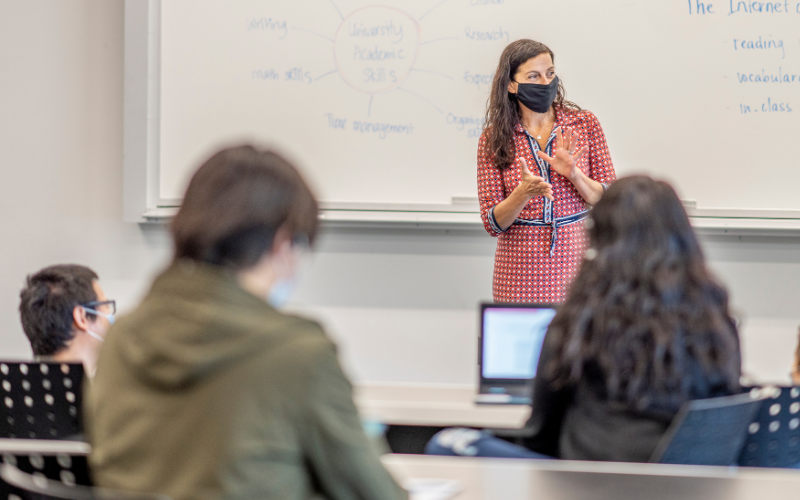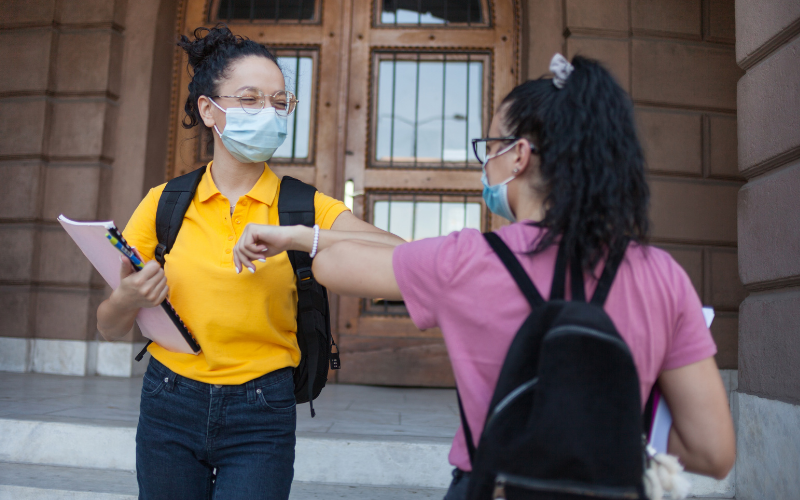Key Takeaways
In order to effectively assess students who are working in a fully remote or hybrid environment, it is important to build remote-friendly assessments that are accessible to all so that you are able to:
- Get a pulse on student progress hourly, daily, and weekly to gauge whether students are understanding the material and where additional support may be needed.
- Engage students in the process of assessment by providing opportunities for student agency and choice over tracking progress and demonstrating mastery.
- Determine clearly whether students have reached mastery by designing ways for students to demonstrate their learning authentically, in a manner that spans the virtual divide.

What is the problem?
Schools are increasingly turning to teaching and learning approaches that span digital and physical spaces, providing more flexibility to students in terms of when and where they learn. To accommodate the need for some (or all) students to learn from home, teachers are often supporting learners in person and remotely – sometimes simultaneously. While dealing with multiple transitions and new modes of instruction, it can be a challenge to find ways to not only engage students but to accurately assess their mastery of content in order to identify which students are ready to move forward, who needs additional support, and who may need to engage with the material in a different way.
Teachers ultimately need to ensure that students are accessing and mastering content regardless of their learning environment. Doing this effectively will be even more crucial as we seek to understand and address differences in student mastery of various concepts and skills. Schools will need to take on these differences in ways that both personalize and accelerate the learning experience, which is why it is crucial to build consistent systems and assessments that can be accessed by students across different learning contexts.
Why is it important?
Assessing students’ understanding is critical to gauge the effectiveness of both the learning experience and instruction, as well as their readiness to move onto the next topic, unit, standard, or phase. This is particularly important when students are learning in non-traditional learning models, like remote and hybrid learning settings, because it becomes even more challenging to ensure students are truly mastering the content.
The research says…
The Learning Accelerator has published a review and synthesis of the academic literature around learning in online and distance environments.
- Effective learning experiences focus on building understanding and competency through cycles of practice, assessment, and feedback. Assessing students informally and formally, as well as providing appropriate support, is critical in making sure students make meaningful progress when working remotely.
- Simply replicating offline approaches and materials for remote learners tends to result in poorer performance, particularly if only some students are learning online. At the same time, teachers should be sure to evaluate online materials and assessment rigor to ensure alignment with standards and appropriate depth.
- Strategies that help learners understand readiness and monitor progress, such as pre-assessments and online quizzes, can support self-direction, engagement, and reflection.
- Technology can support students and teachers as they continuously assess mastery. Embedded quizzes and checks for understanding have been shown to increase learning performance. Online tools, such as blogs and digital portfolios, can be used to offer varied means that encourage active engagement, collaboration, and demonstration of mastery.
How: Solution
As students, families, and staff continue to engage in remote and hybrid learning, educators are building ways to move past engagement to ensure that students are both mastering the content and are able to apply it meaningfully, regardless of their physical location.
When beginning to design remote-friendly assessments, it is important to think through a few key questions:
- How can I embed quick checks for understanding (CFUs) throughout the lesson so that I can gauge where students are on a daily and weekly basis?
- How can I foster student ownership and agency by engaging students in choosing and tracking their own assessments?
- How can I offer my students multiple modalities for assessment so they can more authentically represent their mastery?
The ideas and strategies below provide starting points for you to implement in your classroom and to consider how to build remote-friendly assessments that are accessible to all of your students, in any context.
Get a Pulse on Student Progress
Embedding quick CFUs throughout a lesson can provide teachers with useful insights into their students’ learning progress and help them adjust their instruction in the moment to better meet students’ needs.
When designing remote-friendly assessments that ensure accessibility for all learners, technology tools, as well as video conferencing platforms, can be used to assess understanding synchronously with:
- A quick fist-to-five
- Thumbs up/thumbs down
- Entrance or exit poll
- Shared answers via chat
- Verbal or written CFU
Using the fist-to-five and thumbs up/thumbs down approaches, students would respond using hand gestures either on video (remote students) or in-person. With entrance/exit polls or quick CFUs, all students can respond digitally or via chat. This ensures all students are able to engage simultaneously and give the teacher a brief read on which students are ready to move on and which may need additional support.
This type of quick assessment or CFU can also be done asynchronously by giving students a virtual “interactive handout” or another virtual learning document that accompanies their learning experience (i.e., video, activity, or reading). Though this type of assessment will not shift your synchronous learning time, it can help a student catch misconceptions early and determine whether they need additional support.
Strategies to Explore
Explore the strategies below to find additional ways to get a quick pulse on student learning by leveraging remote-friendly assessments:
Engage Students in Process of Assessment
When developing remote-friendly assessments, think about how you can offer students voice and choice around demonstrating mastery and understanding of the content. When students have more ownership over their learning, they will likely feel more empowered and engaged in the learning process as a whole.
One way to do this is to provide multiple options across various modalities for students to show their learning. By offering different options, students will be able to showcase their understanding effectively through a method of assessment best aligns with their skills and interests. For example, if you are a math teacher and are assessing linear equation graphs, you may offer students the choice to:
- Graph the equations on paper and show their work on the side
- Record themselves talking through each step while digitally drawing on a linear plane in Educreations or Flipgrid
- Complete a real-time assessment with you over Zoom and use a mathematical tool (e.g., Desmos) to graph an equation while sharing their screen
By enabling students to choose the modality that best reflects their understanding as well as track their progress, assessments are not only more accessible but also more engaging. Here are some methods to offer these choices to students in a remote-friendly way:
These are additional key points to consider when engaging students in the process of assessment:
- Be clear on expectations and deliverables: Students should know exactly what they need to submit in order to demonstrate their understanding, regardless of the modality they choose. You may choose to create exemplars for each choice you offer.
- Don’t integrate participation as part of assessment: In the face of the complexities of remote learning, it is hard to gauge participation without truly knowing a student’s home environment. Traditional “good” participation look-fors (e.g., SLANT) may present very differently over Zoom.
Strategies to Explore
Explore the strategies below to find additional ways to engage students in the process of assessment. Note: Many of these strategies can be used in fully in-person or fully remote models, as well.
Determine Clearly Whether Students Have Reached Mastery
No matter where a student is learning, teachers have to assess if the learning experiences students are engaging in are leading to mastery. Design ways in which students can show mastery authentically, spanning the virtual divide and enabling you to get a clear picture of each student's understanding. When designing assessments, consider ways that students can demonstrate their mastery or apply their knowledge (both during a learning experience and at the end of a unit) in a remote-friendly way. Some examples of mastery assessments that span the virtual divide include:
- An online-based test (e.g., built on an LMS or a Google Form)
- A group collaborative project (via Google Document like Remote Buddy Projects)
- A performance task (e.g., Mastery Videos, projects)
Each of these examples help to elucidate students’ mastery of the material and assess whether they are ready to move onto new content. It is also important to think about how you can offer multiple opportunities for students to show understanding. Learning is an ongoing process. If students have not mastered the content, they should be able to demonstrate their understanding again before moving onto the next skill. Especially when working with students in multiple physical locations, it is important to remember that students may be on different timelines due to scheduling, quarantining, or switching between remote and in-person settings, which may cause them to miss out on material or opportunities to effectively display their learning the first time.
Strategies to Explore
Dive into the strategies below to find additional ways to measure mastery authentically in a remote-friendly manner. Note: Many of these strategies can be used in fully in-person or fully remote models, as well.

Take it further
To learn more about effective assessment and/or hybrid learning implementation, explore the additional resources below.